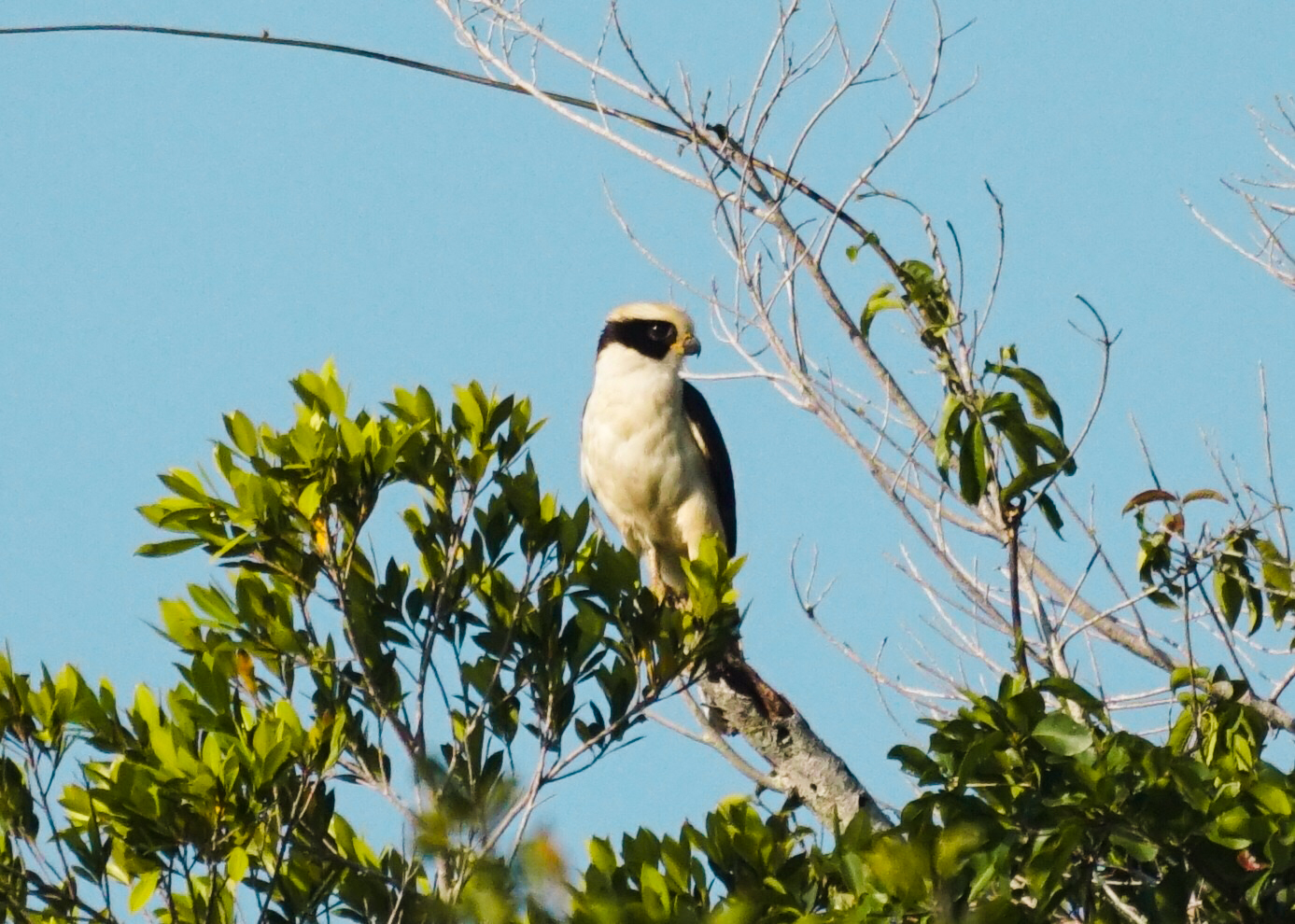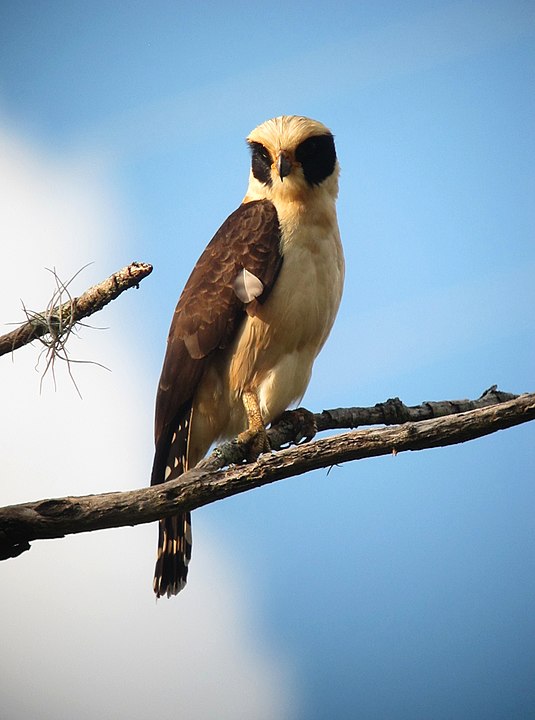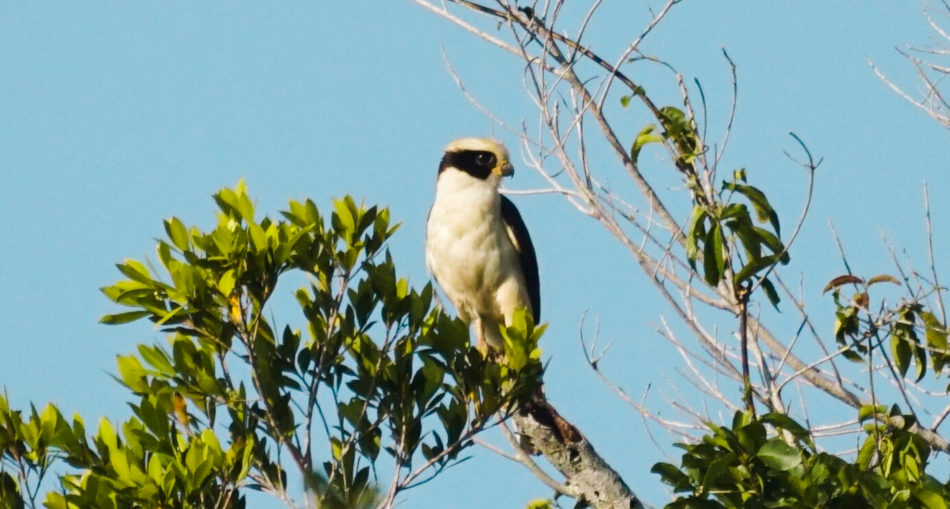The Laughing Falcon is a sizeable bird of prey, and skilled hunter often snatching up the unsuspecting victim. The bird was named after its unique cries mimicking the continuous sounds of human laughter. The scientific name of the Laughing Falcon is Herpetotheres cachinnans. The bird is sometimes called the snake hawk because it is commonly mistaken for a hawk due to its short, rounded wings and a long tail. The Laughing Falcon is native to Mexico and parts of Central America and South America such as the Bolivian-Amazonia region, Brazil, Guyana, Argentina and Paraguay.
Interesting Tip
- Their cries sound like ‘ha-ha har-her-her’ or ‘haww harr herrer’ but when startled, it sounds like ‘hahahahahaha’ or manic laughter.

Description Of The Laughing Falcon
The Laughing Falcon is around forty-six to fifty-six (46-56) cm in length with an approximate wingspan of seventy-nine to ninety-four (79-94) cm. Like other birds of prey, the female Laughing Falcon is larger, weighing about six hundred to eight hundred (600-800) g while the males’ weights are around four hundred and ten to six hundred and eighty (410-680) g.
The adult Laughing Falcon has a light, buff head, alternating between brown and white hues which differs according to each individual. All Laughing Falcons, however, have a broad, black mask reaching from a narrow collar on its neck to its eyes, forming a mask. Feather shafts on their crown are dark while its upper wings and back a blackish-brown colour. Upper tails are whitish barred with white and black but ends in white. Their undersides are pale buff, with light speckling on thighs. Tips of primary remiges are barred with light great with rufous bases. The iris of the Laughing Falcon is dark brown, while the bird has a black bill is black, a pale yellow cere and feet.
The immature birds are different from the adults, having lighter margins on their back feathers, resulting in a scalloped look. Their plumage is not quite white and unfettered parts are also pale. Laughing Falcons’ nestlings have a thick, brownish down, with the adult facial markings beginning to show.
Interesting Tip
- When in flight, a rufous patch its wingtips is revealed by the Laughing Falcon.

A Laughing Falcon – Photo By Félix Uribe, CC BY-SA 2.0, https://commons.wikimedia.org/w/index.php?curid=81342979
Scientific Classification Of The Laughing Falcon
- Kingdom: Animalia
- Phylum: Chordata
- Class: Aves
- Order: Falconiformes
- Family: Falconidae
- Subfamily: Herpetotherinae
- Genus: Herpetotheres
Vieillot, 1817 - Species: H. cachinnans
Habitat Of The Laughing Falcon
The Laughing Falcon inhabits diverse habitats however it seems to prefer humid regions. It lives in open or forested areas with scattered trees like forest clearings or edges at sea elevations up to two thousand and five hundred (2500 ) m.
Diet Of The Laughing Falcon
The Laughing Falcon preys primarily on snakes, even the venomous coral snakes. It also eats lizards, bats, small rodents and centipedes. The bird attacks its prey, landing with a loud thump then bites its nape, an action which sometimes severs the head. The Laughing Falcon then takes its catch to a perch to eat.
Interesting Tip
- The bird can carry small snakes in its bill, swallowing them tail first but carries larger snakes in its claw.
Reproduction Of The Laughing Falcon
The breeding season of the Laughing Falcon is believed to be around April to May but this varies with latitude. The Laughing Falcon is believed to be monogamous, using vocal performances to attract a mate. The courting pairs will perform duets around sunrise and sunset. The Laughing Falcons usually makes their nests in tree cavities, rock crevices and sometimes in the abandoned nests of carcaras or Buteo hawks. Their clutch is often one (1) or at most two (2) eggs with dark brown markings on a pale buff, whites or brown shell. There is little information about the young but they are believed to hatch after forty-five to fifty (45-50) days and fledge around fifty-seven days. After about eight (8) weeks the young are believed to leave the nest.
About The Laughing Falcon
The Laughing Falcon is easily recognized by its dark mask around its eye, stretching towards its back. On the other hand, it can easily be mistaken for a human since the cries of the falcon sound like human laughter. Keep an eye or rather an ear out for this bird of prey, especially around areas with trees.
Article Reference
- https://en.wikipedia.org/wiki/Laughing_falcon
- https://animaldiversity.org/accounts/Herpetotheres_cachinnans/







